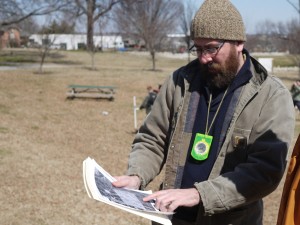Overview
Patterson Park, known as Hampstead Hill in the early 1800s, was the site of Baltimore’s major defensive position against a British land invasion in the War of 1812. With funding from the Maryland Heritage Area Authority and the National Park Service American Battlefield Protection Program, Baltimore Heritage completed an archaeological investigation of Patterson Park in spring 2014. This project was a unique opportunity to research the history of the battle, celebrate Baltimore’s history, and preserve Hampstead Hill and the Eastern Defensive Line for future generations to discover.
Location
Patterson Park, Baltimore, MD
Project Team
Our archaeological consultant for this project is the Louis Berger Group, Inc. Louis Berger is an award-winning environmental planning and engineering firm founded in 1953 and one of the largest providers of cultural resource management services in the nation.
Principal Investigator – Dr. John Bedell
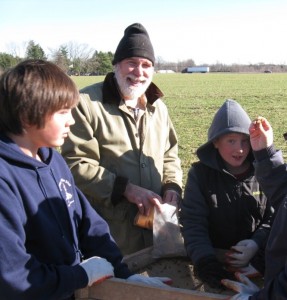
The principal investigator of Louis Berger’s effort is Dr. John Bedell. A resident of Catonsville, Maryland, Dr. Bedell has more than 20 years of experience directing archaeological projects in the Middle Atlantic region. Dr. Bedell is an archaeologist and historian who has led studies on a wide range of resources, from ancient Native American camps to Cold War military bases. He has particular expertise with historic military sites and has conducted several projects within U.S. National Battlefield Parks. Dr. Bedell is the author of five NPS brochures, three of them on battlefields, several popular reports that the National Park Service has published online or for sale, and a forthcoming article on the Battle of Fort Stevens in Washington, DC. Dr. Bedell teaches college courses from time to time, include a current class at Hood College in Frederick, and he is also the author of a self-published mystery novel and the proprietor of a personal web site that has logged more than a million page views.
Fieldwork Director – Greg Katz
The director of day-to-day fieldwork at Patterson Park will be archaeologist and Charles Village resident Gregory Katz. Mr. Katz joined Berger’s team in 2009. He has more than 15 years of experience in the archaeology of the region. He has directed major archaeological studies at the U.S. Naval Academy in Annapolis, at Catoctin Mountain Park near Frederick, at Washington Navy Yard, in D.C., and at several Navy properties in southern Maryland. He also has considerable expertise in GIS mapping. He has developed maps for several National Parks that overlay different sorts of data, such as historic maps, archeological findings, and LIDAR-derived topography, to aid in finding sites and interpreting past landscapes. Mr. Katz is on the Executive Board of the Council for Maryland Archaeology, and volunteers with youth soccer programs in Charles Village.
Field Supervisor – Jason Shellenhamer
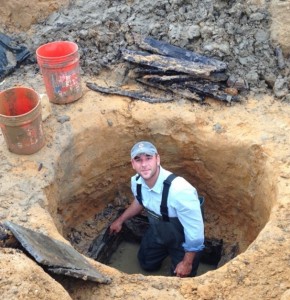
Also part of the project team is archaeologist Jason Shellenhamer, a Lauraville neighborhood resident. Mr. Shellenhamer has 15 years of archeological experience in the region and has been with Berger for seven years. He is an expert historical researcher. Some of his projects have included: directing fieldwork for a multi-year study at the Antietam Battlefield; overseeing excavations at Fort Willard, a Civil War fort in Fairfax, Virginia; directing archaeological studies for the new National Museum of African-American History on the Mall in Washington and the Lee-Fendall House and Garden in Alexandria; multiple studies in the C&O Canal Park, and geophysical exploration of a secret World War II prison camp at Fort Hunt.
Field Archeologist – Ryun Papson
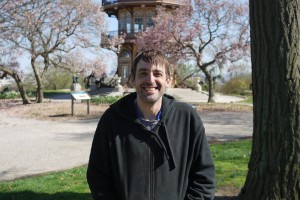 Ryun Papson is a fourteen year resident of Upper Fells Point and has worked professionally as an archaeologist since 1996. He was hired by Louis Berger in March 2014. He has worked as a crew chief, field technician, surveyor and cartographer on projects spanning from the eastern Mediterranean to western Mexico and throughout the Mid-Atlantic United States. His professional interests include archaeological site survey, cartographic methods and design as applied to archaeological contexts, geographic examination of the variable patterns of racial segregation in urban contexts and the material culture of minority and/or immigrant urban communities in the eastern United States.
Ryun Papson is a fourteen year resident of Upper Fells Point and has worked professionally as an archaeologist since 1996. He was hired by Louis Berger in March 2014. He has worked as a crew chief, field technician, surveyor and cartographer on projects spanning from the eastern Mediterranean to western Mexico and throughout the Mid-Atlantic United States. His professional interests include archaeological site survey, cartographic methods and design as applied to archaeological contexts, geographic examination of the variable patterns of racial segregation in urban contexts and the material culture of minority and/or immigrant urban communities in the eastern United States.
Remote Sensing Survey Consultant – Dr. Timothy Horsley
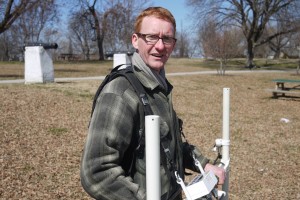 Dr. Timothy Horsley will be participating in the research and will be conducting geophysical (remote sensing) surveys. With M.A. and Ph.D. degrees in archeological prospection from the University of Bradford (United Kingdom), Dr. Horsley established Horsley Archaeological Prospection, LLC, in 2008 and has rapidly become one of the most sought after consultants in eastern North America. His consultancy focuses on archeological studies, and he has worked on
Dr. Timothy Horsley will be participating in the research and will be conducting geophysical (remote sensing) surveys. With M.A. and Ph.D. degrees in archeological prospection from the University of Bradford (United Kingdom), Dr. Horsley established Horsley Archaeological Prospection, LLC, in 2008 and has rapidly become one of the most sought after consultants in eastern North America. His consultancy focuses on archeological studies, and he has worked on
projects on several continents. The geophysical survey techniques he employs provide a non-invasive method to identify buried features, which can range from fire-cracked rock concentrations, to human burials, to palisade lines for Native American villages.
Consulting Project Historian – Scott S. Sheads
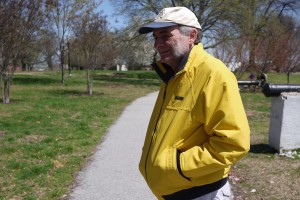 Scott S. Sheads, consulting and contributing project historian is a National Park Ranger/Historian at Fort McHenry National Monument & Historic Shrine who is supporting this effort with 32 years of research experience on the Battle for Baltimore and the Chesapeake campaigns. Scott is well-known in the field of 1812 research for his several published works and lectures. His most recent work due to be released this week is from Osprey Books of London entitled The Chesapeake Campaigns, 1813-1815: Middle Ground of the War of 1812.
Scott S. Sheads, consulting and contributing project historian is a National Park Ranger/Historian at Fort McHenry National Monument & Historic Shrine who is supporting this effort with 32 years of research experience on the Battle for Baltimore and the Chesapeake campaigns. Scott is well-known in the field of 1812 research for his several published works and lectures. His most recent work due to be released this week is from Osprey Books of London entitled The Chesapeake Campaigns, 1813-1815: Middle Ground of the War of 1812.
Archeological Society of Maryland & Community Volunteers
 Our project team is joined by a diverse group of volunteers with the Friends of Patterson Park, the Archeological Society of Maryland, local schools and community residents.
Our project team is joined by a diverse group of volunteers with the Friends of Patterson Park, the Archeological Society of Maryland, local schools and community residents.
Learn more about how you can join our volunteer team.
Partners
- Baltimore Heritage
- Friends of Patterson Park
- Baltimore City Public Schools
- Baltimore City Department of Recreation & Parks (BCRP)
- Baltimore City Commission for Historical and Architectural Preservation (CHAP)
- Archaeological Society of Maryland
Funding
- American Battlefield Protection Program
- Baltimore National Heritage Area
- Maryland Heritage Area Authority
- PNC Bank
Timeline
Our plan for archaeological fieldwork includes both remote sensing and archaeological excavations.
Remote Sensing – March 24 – March 28, 2014
Geophysical remote sensing is a key part of the archaeological strategy. The remote sensing would be carried out by Dr. Timothy Horsley of Horsley Archaeological Prospection LLC., a subconsultant to Louis Berger. Dr. Horsley is planning to use a combination of several instruments in his study: high-resolution magnetometry, ground-penetrating radar, and soil resistivity. All of these techniques are above-ground approaches – they are non-intrusive and non-destructive.
The remote sensing work would begin by using survey instruments to stake out 30-meter survey squares in the park. The survey squares would be marked by either wooden garden stakes or with PVC pin flags which would remain in the park only for the duration of the survey. The survey will begin near the Observatory and then extend north and south, and minimally to the east and west. An overall area measuring about 2 hectares or 5 acres will be investigated. There will be no excavation as part of this phase of the fieldwork. The work will be conducted by 2 field personnel and possibly an additional volunteer.
Archaeological Excavation – April 17 – May 10, 2014
The principal part of the fieldwork plan will be the hand-excavation of test units. The test units will vary in size depending on circumstances. Initially it may be desirable to use a series of 2×5-foot units to span the width of the buried earthworks, in effect forming a narrow trench. In other circumstances, units measuring 3×3 feet may be used. All test units will be excavated to be base of artifact-bearing soils, but will not exceed 4 feet in depth. All excavated soils will be sifted through ¼-inch mesh screen for the recovery of artifacts. Excavation will be conducted with hand-tools, principally shovels and spades, but also trowels. Sifting of soils will take place on top of tarps or plastic sheeting.
At the end of each field day, all open test units will be covered with plywood sheets, and tarps or plastic sheeting. Back-dirt piles will also be covered with tarps or plastic sheeting. Open test unit areas will be additionally marked with caution tape. Test units will typically be backfilled immediately upon completion; however some test units may be left open for the duration of the fieldwork to assist with public interpretation of the site.
Louis Berger will backfill all excavations upon completion of the fieldwork. The excavated soil will be placed back in each test unit, and the soil will be compacted manually. Baltimore Heritage will be responsible for any seeding or placing sod required to restore the backfilled units in consultation with the Friends of Patterson Park and Baltimore City Department of Recreation & Parks.
What is the history of the War of 1812 in Patterson Park?
Patterson Park, known as Hampstead Hill in the early 1800s, was the site of Baltimore’s major defensive position against a British land invasion in the War of 1812. In 1827, Hampstead Hill was converted into a public park now known as Patterson Park. Although historians have long known of the park’s association with the Battle of Baltimore, our project will be the first archaeological exploration in the park to focus on the battle and the War of 1812. Learn more about the history of Patterson Park.
Why look for War of 1812 history in Patterson Park?

In the fall of 1814, British forces mounted a two-pronged attack on Baltimore: the British navy lay siege to Fort McHenry and the harbor while land forces marched on Baltimore from the east. With short notice, Baltimoreans prepared a tremendous defense position against the land invasion along Hampstead Hill. The preparations included digging extensive trenches, creating earthen berms, mounting cannon, and stationing upwards of 20,000 troops to meet the British troops.
What is archaeology? What is battlefield archaeology?
- Archaeology is the study of the ancient and recent human past through material remains. It is a subfield of anthropology, the study of all human culture. An archaeological site is any place where physical remains of past human activities exist. There are many, many types of archaeological sites. A site can be as small as a pile of chipped stone tools left by a prehistoric hunter or as big as a place like Fort McHenry.
- Battlefields and sites, like Patterson Park, associated with wars fought on American soil help provide a means for Americans to understand and interpret various periods in our country’s history. Battlefield archaeology is a subspecialty of archaeology that can help us understand the history of the battle and help us preserve the site for future generations.
What questions are we trying to answer?
Where were the earthworks located on Hampstead Hill?
The most basic question to be answered about the defenses of the city is the location of the earthworks. Locating them accurately is important for at least three reasons. First, once their location is determined they can be protected from future development activity in the park. Second, mapping them with regard to the terrain will reveal the design of the defenses, showing how the defenders took advantage of the terrain in laying out the entrenchments. Third, mapping will allow for better interpretation of the site.
How did the city construct the earthworks?
Excavating sections across the remains of the earthworks should provide information about their construction. Most basically, how deep was the ditch, how tall and thick the berm? This has considerable impact on how we perceive the battle and especially the choices made by the British commanders. If they were looking across the field at truly formidable earthworks, that would put their decision not to attack in a different light than if most of the fortification was low and weak. Excavation might also reveal other details, such as the slope of the fortifications and whether there were cannon platforms in the bastions.
Can we find any other features like privies or magazines?
One of the Civil War maps shows a structure labeled ‘Magazine of 1812’ just behind the bastion in Patterson Park. A magazine was usually dug to a considerable depth to protect the ammunition and the men stationed around it, so this feature is quite likely to survive. Other possible features include privies or pits dug to bury trash.
Did the people who built and camped on the earthworks leave behind any evidence that we can find?
Baltimore was defended by thousands of men who camped around the city for weeks, aided by numerous citizens. Such a large number of people might leave considerable evidence of their presence. Artifacts often found around military camps include bullets and bullet molds, other bits of armaments, buttons and other uniform fragments, horse tack, tobacco pipes, and bottle glass. Discovery of such artifacts dating to 1814 would provide a fascinating connection to the past. If a significant deposit of material dating to 1814 is located, for example in a backfilled privy or a section of the fortification ditch, this might provide information on how the militia of 1814 traveled and camped, how they were equipped, and what they carried with them.
At Patterson Park there has probably been significant disturbance to surface deposits because of landscaping for the park, planting, the construction of roads and paths, and the building of the Observatory and other structures. The park was also occupied by Union regiments during the Civil War, which adds a further layer of disturbance. However, a combination of magnetometry, metal detecting, and hand excavation will be attempted to search for surviving intact features and areas.


